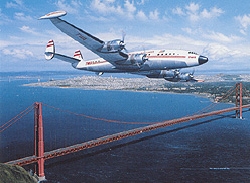|
|
| Sentimental Journey |
|
 |

|
 |
|
|
| DESCRIPTION |
 |
| 16 x 11.5 Inch Collector Size Unframed Lithograph $40.00
The distinctive tri-tailed Lockheed Constellation viewed by many as the epitome of piston-engine airliners was the brain child of Howard Hughes who controlled Transcontinental & Western Airlines. Hughes drew up the initial specifications for this aircraft which was designed under the guidance of C.L. "Kelly" Johnson. As one of the largest airplanes designed up to that point the Connie had a number of firsts including hydraulically boosted controls high lift wing flaps and a fully pressurized cabin. The prototype was completed in 1942 but all production was shifted to military applications. Designated the C-69 by the USAAF the Connie carried Orville Wright on his final flight during its service trials. The aircraft was well received and immediately set a number of performance records. With the end of the War and the onset of the post war recession the Connie was almost canceled. FAA certification was granted on October 14 1945. For safety purposes due to past fire problems with the R-3350 engines fire detection and extinguishing systems were added. The Model 49 had a maximum takeoff weight of 86250 lbs. Eighty-eight Model 49s were sold with TWA and Pan Am accounting for more than half the sales. The Constellation did not have a good safety record in its first few years of operation. One unusual accident occurred when the Plexiglas astrodome broke while the navigator was taking a fix. The navigator was unfortunately blown out of the aircraft. With the Model 649 Lockheed utilized more powerful engines and for the first time utilized a rubber barrier between the inner and outer skins to reduce vibration. The 649 was faster more economical and had a much more comfortable cabin than the first Connie. Eighteen of these aircraft were delivered to Eastern. An improved version of the 649 was introduced in response to the DC-6 and was designated as the Model 749. This model had much greater fuel capacity and range. More than one hundred of these airliners were delivered. The Model 1049 or Super Constellation was first delivered in 1952. It was basically a Model 749 which had been stretched some eighteen feet. Increased fuel capacity and more powerful engines were utilized. Unfortunately the initial 1049s with a gross maximum takeoff weight of 120000 lbs were slower than the DC-6. Only twenty-four Model 1049s were built. In 1953 Lockheed incorporated turbo-compound engines on the Model 1049C. This upped cruising speed to nearly 300 MPH and takeoff weight by an additional 10%. Forty-eight of these aircraft were built but the engines suffered from reliability problems. The major production model of the Super Connie was the 1049G. The G had 609 gallon wing tip tanks which added an additional 700 miles to the Connie's range. The G Model also utilized square windows. The first 1049G flew in 1954. TWA purchased 28 of the 102 Super-Gs which were built. A total of 856 Connies including military versions were produced. The aircraft was phased out by major airlines prior to its useful life being reached because of the introduction of passenger jets. TWA phased out all its Constellations by 1963. In Stan Stokes' magnificent painting a TWA Super Connie departs San Francisco in 1957 for points unknown. |
|


|